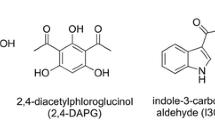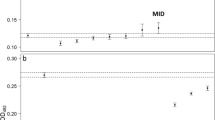Abstract
A powerful mechanism for protection against disease in animals is synergy between metabolites present in the natural microbiota of the host and antimicrobial peptides (AMPs) produced by the host. We studied this method of protection in amphibians in regard to the lethal disease chytridiomycosis, which is caused by Batrachochytrium dendrobatidis (Bd). In this study, we show that the AMPs of Rana muscosa, as well as the metabolite 2,4-diacetylphloroglucinol (2,4-DAPG) from Pseudomonas fluorescens, a bacterial species normally found on the skin of R. muscosa, were inhibitory to the growth of Bd in vitro. When both AMPs and 2,4-DAPG were used in growth inhibition assays, they worked synergistically to inhibit the growth of Bd. This synergy resulted in reduced minimum concentrations necessary for inhibition by either 2,4-DAPG or AMPs. This inhibitory concentration of AMPs did not inhibit the growth of a P. fluorescens strain that produced 2,4-DAPG in vitro, although its growth was inhibited at higher peptide concentrations. These data suggest that the AMPs secreted onto frog skin and the metabolites secreted by the resident beneficial bacteria may work synergistically to enhance protection against Bd infection on amphibian skin. These results may aid conservation efforts to augment amphibian skins’ resistance to chytridiomycosis by introducing anti-Bd bacterial species that work synergistically with amphibian AMPs.




Similar content being viewed by others
References
Berg, G., Grosch, R., and Scherwinski, K. 2007. Risikofolgeabschätzung für den Einsatz mikrobieller Antagonisten: Gibt es Effekte auf Nichtzielorganismen? Gesunde Pflanzen 59:107–117.
Berger, L., Speare, R., Daszak, P., Green, D. E., Cunningham, A. A., Goggin, C. L., Slocombe, R., Ragan, M. A., Hyatt, A. D., Mcdonald, K. R., Hines, H. B., Lips, K. R., Marantelli, G., and Parkes, H. 1998. Chytridiomycosis causes amphibian mortality associated with population declines in the rain forests of Australia and Central America. Proc. Natl. Acad. Sci. U. S. A. 95:9031–9036.
Berger, L., Hyatt, A. D., Speare, R., and Longcore, J. E. 2005. Life cycle stages of the amphibian chytrid Batrachochytrium dendrobatidis. Dis. Aquat. Org. 68:51–63.
Briggs, C. J., Vredenburg, V. T., Knapp, R. A., and Rachowicz, L. J. 2005. Investigating the population-level effects of chytridiomycosis: An emerging infectious disease of amphibians. Ecology 86:3149–3159.
Brucker, R. M., Harris, R. N., Schwantes, C. R., Gallaher, T. N., Flaherty, D. C., Lam, B. A., and Minbiole, K. P. C. 2008a. Amphibian chemical defense: Antifungal metabolites of the microsymbiont Janthinobacterium lividum on the salamander Plethodon cinereus. J. Chem. Ecol. 34:1422–1429.
Brucker, R. M., Baylor, C. M., Walters, R. L., Lauer, A., Harris, R. N., and Minbiole, K. P. C. 2008b. The identification of 2,4-diacetylphloroglucinol as an antifungal metabolite produced by cutaneous bacteria of the salamander Plethodon cinereus. J. Chem. Ecol. 34:39–43.
Cassone, M. and Otvos JR, L. 2010. Synergy among antibacterial peptides and between peptides and small-molecule antibiotics. Expert Rev. Anti-Infect. Ther. 8:703–716.
Collins, J. P. and Storfer, A. 2003. Global amphibian declines: Sorting the hypotheses. Divers. Distrib. 9:89–98.
Conlon, J. M., Kolodziejek, J., and Nowotny, N. 2004. Antimicrobial peptides from ranid frogs: Taxonomic and phylogenetic markers and a potential source of new therapeutic agents. Biochim. Biophys. Acta 1696:1–14.
Conlon, J. M., Woodhams, D. C., Razaa, H., Coquet, L., Leprince, J., Jouenne, T., Vaudry, H., and Rollins-Smith, L. A. 2007. Peptides with differential cytolytic activity from skin secretions of the Lemur leaf frog Hylomantis lemur (Hylidae: Phyllomedusinae). Toxicon 50:498–506.
Daly, J. W. 1995. The chemistry of poisons in amphibian skin. Proc. Natl. Acad. Sci. U. S. A. 92:9–13.
Harris, R. N., James, T. Y., Lauer, A., Simon, M. A., and Patel, A. 2006. Amphibian pathogen Batrachochytrium dendrobatidis is inhibited by the cutaneous bacteria of amphibian species. EcoHealth 3:53–56.
Harris, R. N., Lauer, A., Simon, M. A., Banning, J. L., and Alford, R. A. 2009a. Addition of antifungal skin bacteria to salamanders ameliorates the effects of chytridiomycosis. Dis. Aquat. Org. 83:11–16.
Harris, R. N., Brucker, R. M., Walke, J. B., Becker, M. H., Schwantes, C. R., Flaherty, D. C., Lam, B. A., Woodhams, D. C., Briggs, C. J., Vredenburg, V. T., and Minbiole, K. P. 2009b. Skin microbes on frogs prevent morbidity and mortality caused by a lethal skin fungus. ISME J. 3:818–824.
Hoffman, M., et al. 2010. The impact of conservation on the status of the world’s vertebrates. Science 330:1503–1509.
Kilpatrick, A., Briggs, C., and Daszak, P. 2010. The ecology and impact of chytridiomycosis: An emerging disease of amphibians. Trends Ecol. Evol. 25:109–118.
Lam, B. A., Walke, J. B., Vredenburg, V. T., and Harris, R. N. 2010. Proportion of individuals with anti-Batrachochytrium dendrobatidis skin bacteria is associated with population persistence in the frog Rana muscosa. Biol. Conserv. 143:529–531.
Lauer, A., Simon, M. A., Banning, J. L., andre, E., Duncan, K., and Harris, R. N. 2007. Common cutaneous bacteria from the eastern red-backed salamander can inhibit pathogenic fungi. Copeia 2007:630–640.
Lauer, A., Simon, M. A., Banning, J. L., Lam, B., and Harris, R. N. 2008. Diversity of cutaneous bacteria with antifungal activity isolated from female four-toed salamanders. ISME J. 2:145–157.
Lips, K. R., Brem, F., Brenes, R., Reeve, J. D., Alford, R. A., Voyles, J., Carey, C., Livo, L., Pessier, A. P., and Collins, J. P. 2006. Emerging infectious disease and the loss of biodiversity in a Neotropical amphibian community. Proc. Natl. Acad. Sci. U. S. A. 103:3165–3170.
Minteer, B. A. and Collins, J. P. 2008. From environmental to ecological ethics: Toward a practical ethics for ecologists and conservationists. Sci. Eng. Ethics 14:483–501.
Pask, J. D., Woodhams, D. C., and Rollins-Smith, L. A. 2012. The ebb and flow of antimicrobial skin peptides defends northern leopard frogs (Rana pipiens) against chytridiomycosis. Glob. Chang. Biol. 18:1231–1238.
Ramsey, J. P., Reinert, L. K., Harper, L. K., Woodhams, D. C., and Rollins-Smith, L. A. 2010. Immune defenses against Batrachochytrium dendrobatidis, a fungus linked to global amphibian declines, in the South African clawed frog, Xenopus laevis. Infect. Immun. 78:3981–3992.
Rollins-Smith, L. A. 2009. The role of amphibian antimicrobial peptides in protection of amphibians from pathogens linked to global amphibian declines. Biochim. Biophys. Acta 1788:1593–1599.
Rollins-Smith, L. A. and Conlon, J. M. 2005. Antimicrobial peptide defenses against chytridiomycosis, an emerging infectious disease of amphibian populations. Dev. Comp. Immunol. 29:589–598.
Rollins-Smith, L. A., Carey, C., Longcore, J., Doersam, J. K., Boutte, A., Bruzgal, J. E., and Conlon, J. M. 2002. Activity of antimicrobial skin peptides from ranid frogs against Batrachochytrium dendrobatidis, the chytrid fungus associated with global amphibian declines. Dev. Comp. Immunol. 26:471–479.
Rollins-Smith, L. A., Woodhams, D. C., Reinert, L. K., Vredenburg, V. T., Briggs, C. J., Nielsen, P. F., and Conlon, J. M. 2006. Antimicrobial peptide defenses of the mountain yellow-legged frog (Rana muscosa). Dev. Comp. Immunol. 30:831–842.
Scherwinski, K., Grosch, R., and Berg, G. 2008. Effect of bacterial antagonists on lettuce: Active biocontrol of Rhizoctonia solani and negligible, short-term effects on nontarget microorganisms. FEMS Microbiol. Ecol. 64:106–116.
Simmaco, M., Mignogna, G., and Barra, D. 1998. Antimicrobial peptides from amphibian skin: What do they tell us? Biopolymers 47:435–450.
Simon, S. N., Chancon, J. S., Cox, N. A., Young, B. E., Rodrigues, A. S. L., Fischman, D. L., and Waller, R. W. 2004. Status and trends of amphibian declines and extinctions worldwide. Science 306:1783–1786.
Vredenburg, V. T., Briggs, C. J., and Harris, R. 2011. Host-pathogen dynamics of amphibian chytridiomycosis: The role of the skin microbiome in health and disease, pp. 342–355, in L. Olsen, E. R. Choffnes, D. A. Relman, and L. Pray (eds.), Fungal Diseases: An Emerging Threat to Human, Animal, and Plant Health. The National Academies Press, Washington, D. C.
Weldon, C., du Preez, L. H., Hyatt, A. D., Muller, R., and Speare, R. 2004. Origin of the amphibian chytrid fungus. Emerg. Infect. Dis. 10:2100–2105.
Woodhams, D. C., Voyles, J., Lips, K. R., Carey, C., and Rollins-Smith, L. A. 2005. Predicted disease susceptibility in a Panamanian amphibian assemblage based on skin peptide defenses. J. Wildl. Dis. 42:207–218.
Woodhams, D. C., Rollins-Smith, L. A., Carey, C., Reinert, L., Tyler, M. J., and Alford, R. 2006. Population trends associated with antimicrobial peptide defenses against chytridiomycosis in Australian frogs. Oecologia 46:531–540.
Woodhams, D. C., Ardipradja, K., Alford, R. A., Marantelli, G., Reinert, L. K., and Rollins-Smith, L. A. 2007a. Resistance to chytridiomycosis varies by amphibian species and is correlated with skin peptide defenses. Anim. Conserv. 10:409–417.
Woodhams, D. C., Rollins-Smith, L. A., Alford, R. A., Simon, M. A., and Harris, R. N. 2007b. Response - Innate immune defenses of amphibian skin: antimicrobial peptides and more. Anim. Conserv. 10:425–428.
Woodhams, D. C., Vredenburg, V. T., Stice, M. J., Simon, M. A., Billheimer, D., Shakhtour, B., Shyr, Y., Briggs, C. J., Rollins-Smith, L. A., and Harris, R. N. 2007c. Symbiotic bacteria contribute to innate immune defenses of the threatened mountain yellow-legged frog, Rana muscosa. Biol. Conserv. 138:390–398.
Zasloff, M. 2002. Antimicrobial peptides of multicellular organisms. Nature 415:389–395.
Acknowledgments
This work was supported by a National Science Foundation EAGER grant (DEB-1049699) and an NSF MRI grant (CHE-0958973). The authors wish to thank Dr. Kyle Seifert (James Madison University) for his expertise and for providing laboratory space.
Author information
Authors and Affiliations
Corresponding author
Electronic Supplementary Material
Below is the link to the electronic supplementary material.
Supplemental Fig. 1
Inhibition of Batrachochytrium dendrobatidis growth in vitro by mixtures of AMPs and 2,4-DAPG. A statistically significant interaction between Rana muscosa AMPs and 2,4-DAPG exists as determined by ANOVA (F = 6.13; df = 8,63; P < 0.001). This assay was conducted twice, with ten total replicates per sample. All points denote means, and standard error bars have been omitted for clarity (DOCX 13 kb)
Rights and permissions
About this article
Cite this article
Myers, J.M., Ramsey, J.P., Blackman, A.L. et al. Synergistic Inhibition of the Lethal Fungal Pathogen Batrachochytrium dendrobatidis: The Combined Effect of Symbiotic Bacterial Metabolites and Antimicrobial Peptides of the Frog Rana muscosa . J Chem Ecol 38, 958–965 (2012). https://doi.org/10.1007/s10886-012-0170-2
Received:
Revised:
Accepted:
Published:
Issue Date:
DOI: https://doi.org/10.1007/s10886-012-0170-2




